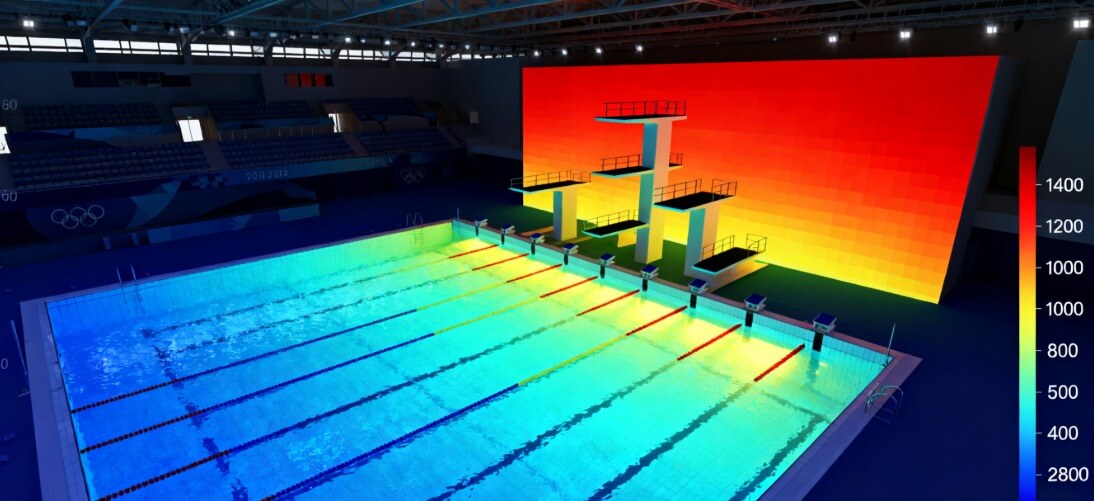巴黎2024年水上运动中心采用奥运级LED体育场照明

快速参考:巴黎 2024 年水上运动中心 LED 体育场照明规格
下表总结了巴黎2024年水上运动中心为满足转播和比赛需求而制定的LED体育场馆照明规格。这些基准对于寻求体育场馆LED照明最佳实践的场地设计师、工程师和运营商来说非常有用。
| 范围 | 巴黎2024水上运动中心目标 | 目的/说明 |
|---|---|---|
| 平均垂直照度(Ev) | 1,400–1,600 勒克斯(面向摄像头的平面上) | 确保 OBS 和高帧率摄像机的广播级可见性。 |
| 水平照度(Eh) | 1,000–1,200 勒克斯(泳池甲板和潜水区) | 确保比赛区域的运动员安全和观众的清晰度。 |
| 均匀度(U1、Ev/Eh) | ≥0.7 | 保持球道、板和比赛场地的均匀覆盖。 |
| 相关色温(CCT) | 5,600 K±300 K | 与广播的日光平衡相匹配,确保镜头中的肤色自然。 |
| 显色指数(CRI) | ≥90 | 确保运动员、水域和场地品牌的色彩准确再现。 |
| 驾驶员表现 | 无闪烁,> 2 kHz 高频调制 | 防止广播重播期间出现慢动作闪烁和时间伪影。 |
| 眩光控制 | 非对称光学+屏蔽 | 保护运动员的视线并减少镜面水反射。 |
| 可持续性因素 | 低功率密度(< 15 W/m²)、光伏集成、可重复使用的覆盖装置 | 支持能源效率、再利用和减少碳足迹。 |
2024年巴黎奥运会水上运动中心证明了现代LED体育场馆照明在提供奥运标准性能方面已取得巨大进步。该照明项目旨在应对运动员可见度、卓越转播质量和可持续长期运行的三重挑战,将永久性体育场馆灯具与由SLX运营的临时转播“覆盖”装置相结合。这种双重方案使场馆既能满足奥林匹克转播服务(OBS)的要求,又能支持中心在赛后发挥的社区作用。
这是体育场馆LED照明首次以模块化系统的形式应用于如此规模的体育场馆,旨在满足精英赛事和传统用途的需求。巴黎2024年奥运会的照明模式现已被全球效仿,成为水上运动和室内体育场馆的新标准。
目录:
1.水上运动照明设计原则

水上运动项目的照明极其复杂。反射、高速运动、多个摄像机角度以及运动员的视线都需要在一个综合方案中得到平衡。在2024年巴黎奥运会上,LED体育场馆照明设计遵循了四个关键原则:
双区域照明:
比赛泳池和跳水台采用独立的垂直和水平勒克斯目标。光度建模(使用 IES 文件和 3D 模拟渲染)确保运动员和摄像机都能获得一致的、可直播的光照水平。眩光抑制和视线保护:
灯具采用非对称光学设计,消除游泳和跳水运动员的头顶眩光。倾斜的吊装和遮蔽技术确保光线不会进入运动员的眼睛,也不会遮挡转播摄像机的视野。水面反射控制
设计师精心设计了光入射角模型,以尽量减少水面眩光和流水的镜面反射——这是跳水和花样游泳项目中的关键因素。分层照明,满足多观众需求
。该方案不仅针对运动员,还针对场馆内观众和全球转播摄像机进行了调整。预设模式可在奥运会决赛、热身赛和社区活动之间快速切换。
最终的结果是一个统一、无闪烁、视觉舒适的环境,可为每个利益相关者提供无缝的服务。
2. LED 体育场照明规格和广播就绪设置
巴黎 2024 年冬奥会采用了混合系统:永久性 LED 灯具用于场馆的日常运营,并辅以广播覆盖以满足奥运会的超高标准。
高垂直照度
:摄像机朝向表面的照度达到1,400-1,600勒克斯,且在泳道和跳水板上保持高度均匀。这已通过光度模拟验证,并在OBS调试期间得到确认。一致的色温
灯具对准~5,000K,以确保多摄像机广播的色调一致,避免在现场剪辑或重播期间出现色彩变化。无闪烁驱动器
高频(>5,000 Hz)驱动器确保超慢动作回放画面中无可见闪烁。平滑的调光曲线可实现场景切换,且不会产生时间伪影。灯具性能与吊挂:
高输出防水LED泛光灯搭配精密光束控制光学元件。每个灯具均使用其IES曲线进行模拟,以确认勒克斯目标值并优化吊挂负载。
总之,这些规格凸显了体育场馆 LED 照明在广播质量和可持续性方面如何胜过旧的金属卤化物或 HPS 系统。
.png)
3. 广播集成和 OBS 合规性
Meeting OBS (Olympic Broadcasting Services) broadcast standards was non-negotiable for the Paris 2024 Aquatics Centre. With billions of global viewers depending on crystal-clear coverage, every element of the lighting design had to exceed international benchmarks for professional sports broadcasting. The venue achieved compliance through meticulous attention to three critical factors:
Vertical lux & gradients – The LED stadium lights were calibrated to provide precise vertical illuminance across athletes, swimming lanes, and diving platforms. This ensured that 4K and HDR cameras captured balanced brightness, avoiding underexposed areas or excessive glare. Even in dynamic movements, athletes remained evenly lit, enhancing both visibility and broadcast clarity.
Uniformity ratios – Consistency was key to producing broadcast-ready visuals. Engineers designed the sports stadium LED lighting layout to achieve uniform light distribution across reflective water surfaces and elevated dive platforms. This minimized luminance variation, preventing distracting hotspots or shadowed zones and ensuring smooth, professional-quality images throughout live coverage.
Temporal stability – To meet slow-motion and high-frame-rate broadcast requirements, the system was rigorously tested for flicker across all dimming levels. Ceramiclite's advanced LED stadium lights technology delivered stable, flicker-free illumination, verified by comprehensive on-site testing with broadcast cameras.
Together, these measures allowed the Aquatics Centre's LED stadium lights to deliver flawless, broadcast-grade visuals. From athletes’ facial expressions to the crisp contrast of lane markers under water, every detail was captured with precision—bringing the excitement of Paris 2024 to billions of viewers around the world without compromise.
4. Venue Operation, Sustainability & Legacy
Unlike previous Olympic Games, Paris 2024 placed strong emphasis on long-term venue legacy and sustainability. The lighting strategy was carefully designed to balance short-term event needs with long-term community benefits:
Overlay vs. permanent system – To meet Olympic Broadcasting Services (OBS) requirements, SLX deployed a temporary rig that could handle the demanding broadcast lux levels. Once the Games concluded, this overlay was dismantled and redeployed for other international events. At the same time, the Aquatics Centre retained its permanent high-performance LED stadium lights, ensuring efficient daily operations for training, competitions, and public use.
Energy efficiency – By replacing traditional luminaires with modern LED stadium lights, the venue cut electricity consumption by more than 40%, a saving amplified by reduced HVAC cooling loads since LEDs generate less radiant heat. This not only lowered operating expenses but also reduced the building’s overall carbon footprint.
Sustainability focus – Temporary systems were designed with repurposing in mind, allowing them to be reused for future global sporting events. The permanent fixtures were built with modular components, enabling upgrades, resale, or recycling at the end of their lifecycle. This circular design philosophy set a new benchmark for responsible sports infrastructure.
Together, these decisions underscored Paris 2024's ambition to host the most sustainable Olympic Games in history—showcasing how cutting-edge LED stadium lighting can contribute to both event excellence and long-term community value.
5. Design Takeaways for Other Sports Venues
The Paris 2024 Aquatics Centre offers replicable lessons for other stadium and arena projects:
Model before installation — Use 3D photometric simulations to predict reflections, glare, and uniformity.
Design for multiple audiences — Plan layered lighting for athletes, spectators, and broadcasters.
Validate flicker-free drivers — Test temporal light stability for high-speed broadcast conditions.
Prioritize reusability — Select fixtures that can be repurposed, resold, or adapted for community use.
These strategies make LED stadium lighting not only a performance choice but also a sustainability strategy.
6. Conclusion: New Bar for LED Stadium Lights
The Paris 2024 Olympic Aquatics Centre demonstrated how LED stadium lights and advanced sports stadium LED lighting design can balance elite performance, flawless broadcast delivery, and environmental responsibility. By combining precise glare control, photometric modelling, and sustainable planning, the venue has become a blueprint for future stadiums worldwide.
For any arena or aquatic centre seeking to modernize, the Paris 2024 project shows that LED stadium lighting is the gold standard — delivering superior athlete visibility, broadcast-ready conditions, and long-term energy savings.
_thumb.jpg)